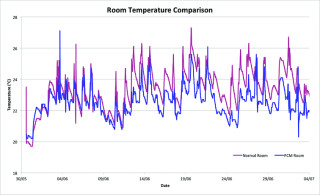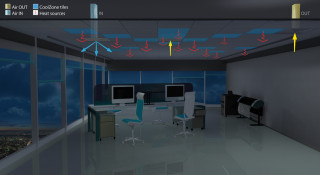The Priority Schools Building Programme (PSBP) heralds a new era for school design. Under the initiative, draught-free ventilation is now mandatory and there is an expectation that passive cooling using thermal mass will be included in a school design. Schemes also have to comply with a facilities output specification which includes measures to limit overheating in schools.
In February, the government named 277 schools that would receive a share of the £2bn funding pot to refurbish or rebuild buildings under the second phase of the programme; this is in addition to phase one which awarded funding to 260 schools in May 2012. The PSBP was launched in 2011 as a successor to the Building Schools for the Future (BSF) programme. Under the BSF schools had to comply with the demands of Building Bulletin 101: Ventilation of School Buildings. This includes the requirement that pupils have sufficient quantity of fresh air and that schools do not get too hot in summer. However, a study by BRE for the Department for Education in 2006, which looked at eight naturally-ventilated schools built under BSF, found that in winter half of these schools simply did not open their windows for fresh air because the untreated air coming in was too cold.
The PSBP places a greater emphasis on the comfort of pupils. To tackle the issue of untreated cold air, the PSBP no longer allows designers to bring in cold air from the outside directly onto the occupants. Instead, the outside air has to be mixed with enough warm air to mitigate any cold draughts. In addition, to prevent overheating in classrooms in summertime the PSPB introduces the concept of operative temperature as a means to define pupils’ comfort. This is a new way of thinking; operative temperature is a function of air temperature, humidity, air speed and the temperatures of the surfaces to which the occupants are exposed. The PSBP also introduces the concept of a variable maximum internal air temperature, termed the “running mean temperature”, which is based on allowing the maximum internal temperature in a space to vary, depending on the maximum outside air temperatures over the previous seven days.
Designers have to use the internal temperature and the running mean temperature to prove a design’s compliance with a new set of overheating criteria. These define:
• the number of hours the maximum internal temperature can be exceeded in a year;
• the number of hours per day above an allowable maximum temperature, multiplied by the number of degrees above the allowable maximum;
• and a maximum value of 4°C above the running mean temperature for the indoor operative temperature.

A design must pass two out of three of these criteria.
Exposed thermal mass is an important tool in helping designers and contractors meet these criteria. Exposed surfaces with a high thermal mass, such as concrete walls or soffits, can absorb and retain large amounts of heat energy to help keep a space cool. This heat can subsequently be released at night using night ventilation to recharge the surfaces ready for the next day.
However, to meet challenging construction programmes schools are often built using lightweight or modular construction techniques such as timber frame, structural insulated panels systems (SIPS) or prefabricated modular components. This type of construction has very little inherent thermal mass and as a consequence does not offer the same resistance to temperature rises as heavyweight construction techniques, making them prone to overheating in summer. The threat of overheating is likely to increase as the climate continues to warm, particularly in high-occupancy spaces such as classrooms. Sustainability consultant Bill Gething recognised the overheating challenge in his landmark report Design for Future Climate for the Technology Strategy Board. In it he said: “Of all the projected climate impacts, hotter summers will affect the design of buildings the most”.


Gething also highlighted the potential for innovative technologies to help meet the challenges of designing buildings for a changing summer climate. In particular he acknowledged the potential for “affordable, safe, phase change materials [PCMs] to provide the performance of thermal mass without the weight of associated conventional materials”. What makes PCMs so special is that they use the latent heat of solidification or melting (a phenomenon familiar to anyone with a GCSE in physics) and hence can absorb far greater amounts of energy than an equivalent conventional material. They have the ability to change phase at room temperature, usually from a solid to a liquid and back again. Chemical companies have developed PCMs specifically for this type of application. BASF’s Micronal PCM, for example, comprises thousands of microscopically small polymer encapsulated spheres, each with a wax core developed to exploit latent heat storage. Since melting and solidifying happens inside each microcapsule, the material remains solid even if heat is being taken up or released. BASF’s Micronal PCM has been incorporated into various construction products including plasterboard and ceiling tiles. Among them are Armstrong Ceiling Systems’ CoolZone tiles, which incorporate Micronal PCM microcapsules designed so that the wax melts as the room air temperature approaches 23°C.

As it changes phase, the wax soaks up heat from the room, a process that continues until all of the wax has changed phase. Then at night, with the use of night ventilation, the tiles can then release this absorbed heat once the room temperature starts to drop below 23°C. As it releases heat the liquid PCM returns to its solid state.
Armstrong Ceilings has worked with natural ventilation specialist Breathing Buildings to develop an integrated system incorporating CoolZone ceiling tiles and Breathing Buildings’ e-stack ventilation system to enable designs to meet the PSBP facilities output specification. On a summer’s day the system will typically work in three modes. First, in the morning the e-stack ventilation system will operate in conjunction with manually-opening windows to exploit free cooling from outside air. Then, once the external temperature rises above internal temperatures, classroom windows are closed and the system switches to minimum ventilation mode based on CO2 levels in the room. In this mode the PCM incorporated into the CoolZone ceiling tiles will absorb heat from the room, helping keep the pupils comfortable.
The final mode of operation is to use night ventilation to allow cooler night air to remove the absorbed heat from the PCM, recharging it ready for the next day.
The system was successfully tested at the Belvoir High School, Nottinghamshire, where two classrooms with suspended ceilings and a Breathing Buildings R-Series e-stack through the roof ventilation unit were compared. For the test 20m2 of conventional ceiling tiles were replaced by CoolZone tiles in one of the classrooms. The results (see graph) show that when the rooms were occupied during the day, the room with the Micronal PCM embedded in the ceiling tiles was generally 1-2°C cooler than the room without the PCM installed.
This article first appeared in the May 2015 issue of The Construction Index magazine. To read the full magazine online, click here.
To receive you own hard copy each month in traditional paper format, you can subscribe at
http://www.theconstructionindex.co.uk/magazine#
Got a story? Email news@theconstructionindex.co.uk



